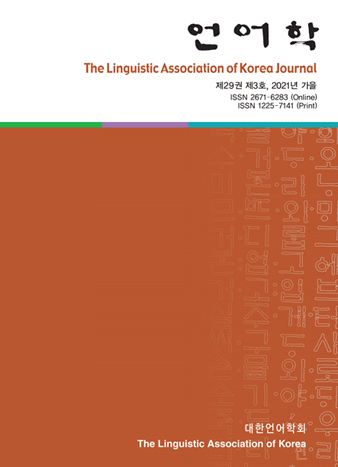대한언어학회 전자저널
Abstract
Kim, Youngcheol. (2021). A study of integrative English teaching and learning using science contents. The Linguistic Association of Korea Journal, 29(3), 1-20. This study examined how to teach English using science contents in an elementary English classroom. This study first proposed an integrative teaching plan using science contents in the elementary English classroom. Then, this study examined this plan during the second semester in 2020. There were 90 participants, all 5th year elementary school students. They were divided into two groups, control and experimental. Both the control group and the experimental group were composed of 45 students each. All the participants in the experimental group were integratively taught using science contents. All the participants in the control group were taught based on the elementary English curriculum. All of the participants were also given a before and after-achievement test and a questionnaire on affective domains. It can be concluded that the experimental group achieved higher than the control group. Additionally, the experimental group showed a greater degree of interest than the control group. It is, therefore, recommended that teachers use contents from other subjects more often to teach elementary school students. As well, teachers should be given sufficient time to do research at their schools. It is also recommended that teachers be allowed to create teaching materials with no restrictions regarding the integrative English teaching plan.
Keywords
# 과학(science) # 초등교실(elementary classroom) # 통합적 영어 (integrative English)
References
- 김미림. (2017). 음악과 통합수업을 위한 창의적인 음악극 활동 방안. 조선대학교 석사 학위논문.
- 김상경. (2015). 영작문과 영어발표 수업을 통합한 교수법이 영작문학습에 끼치는 학습 효과. 영어영문학연구, 57(4), 67-94.
- 김수연. (2015). 심미적 경험을 위한 음악과 중심의 통합수업 프로그램 개발 연구: 보로딘의 「중앙아시아의 초원에서」를 중심으로. 이화여자대학교 석사학위논문.
- 김시현. (2015). 과학과 음악의 통합수업. 제주특별자치도교육청.
- 김영철, 김정훈. (2009). 초등영어 통합교과 지도방법. 서울: 글로벌콘텐츠. 김영철. (2013). 초등영어교육 알기. 서울: 한국문화사.
- 김평원. (2015). 중학교 자유 학기에 실현된 통합수업을 통해 본 초등학교 통합 프로젝 트의 방향. 한국초등국어교육, 59, 69-103.
- 김효비. (2016). 교과 통합수업이 중학교 영어 학습자의 읽기 및 정의적 태도에 미치는 영향. 이화여자대학교 석사학위논문.
- 박기범. (2015). 문학과 만화 통합수업의 개발 및 적용 -대학 교양 강좌 사례를 중심으로-. 학습자중심교과교육, 15(12), 387-406.
- 박미혜. (2014). 통합 수업을 통한 창의적 수업 방안 모색. 제주특별자치도교육청. 서명희, 김종철. (2014). 창의적 문제 발견 능력 함양을 위한 문학·경제 통합 교육: 언어적 창의성을 중심으로. 학습자중심교과교육, 14(7), 77-99.
- 신준협. (2015). 창조성 신장을 위한 교과 간 통합 수업 방안. 창조교육논총, 17, 105-117. 유정애, 진연경. (2016). 올림픽교육을 통한 자유학기제 체육활동의 통합수업 설계방안 탐색. 한국스포츠교육, 23(1), 23-39.
- 윤수영, 김동희, 김유경, 김민경. (2015). 수학·과학 통합수업 개발 및 적용 사례(중학년): 명탐정 똘똘이의 경주 보물 완전 정복. 대한수학교육학회. 대한수학교육학회 학술 대회 포스터 전시회 발표논문, 건국대학교, 5월 1-2일.
- 이재경. (2017). 특성화 고등학교 교과 통합 프로젝트 기반의 국어과 통합 수업 방안. 한 국교원대학교 석사학위논문.
- 이희영. (2016). 최소제곱법을 활용한 통합수업 소재 연구. 한국외국어대학교 석사학위 논문.
- 임유정. (2012). 수학 교과와 타 교과간의 통합 수업 모형의 개발 및 적용 과정에 대한 연구. 영남대학교 석사학위논문.
- Brown, H. D. (2007). Teaching by principles: An interactive approach to language pedagogy (3rd ed.). White Plains, NY: Addison Wesley Longman.
